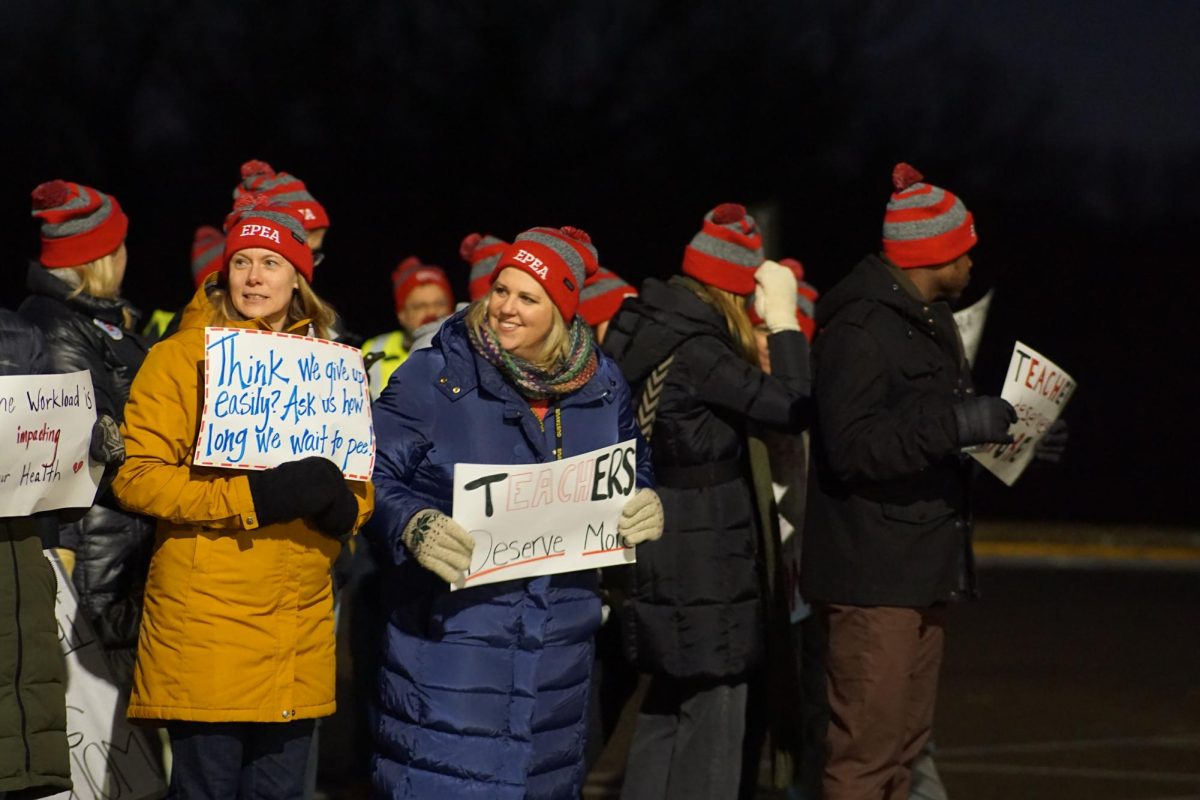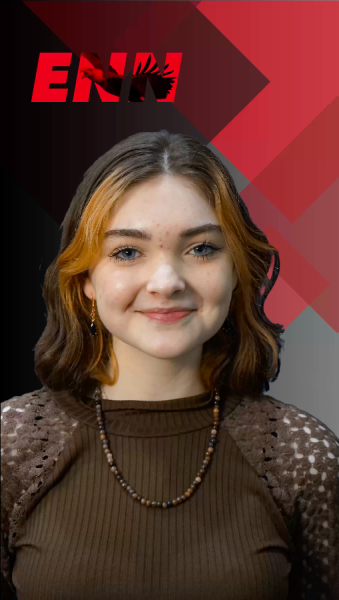On a cold Monday night, many current and former teachers, journalists, students, and parents Eden Prairie community members gathered with signs, megaphones, and smiles outside the Administrative Building to continue negotiation for their biennial employment strategy and policy contract. Some were able to watch from the meeting room, but the remaining supporters, mainly composed of school district 272 teachers, stood outside in the January cold.
On January 22nd, with their breaths visible and heads covered with ‘EPEA’ beanies, educators stood below the window of the meeting room. A large speaker was set up beneath the meeting room which was connected to the livestream the School Board was hosting. That way, those who could not fit in the room were still able to listen to those who volunteered to speak on behalf of their negotiation. Even with hot cocoa in their hands, the cold and the threat piles of papers to grade hung above the teachers’ heads.
One sign, written by a science teacher at Eden Prairie High School, said, “I would stay, but I have papers to grade.” Countless other Eden Prairie teachers, are a part of the Eden Prairie Education Association (EPEA), who have been negotiating since the summer for recognition and appreciation from their employers, the School Board. The reason teacher contracts are being negotiated is complicated but can be brought down to three main factors; the needing of more protection and safety within the school, protecting smaller class sizes, and allocating enough money to educators so they make a livable wage.
The way money trickles down into our schools is through a long and complicated taxation process. Surprisingly, tax dollars are not necessarily allocated to the schools or the students in the neighborhood/district of the taxpayer. “Tax revenue is collected and distributed to schools throughout a district, and in a growing number of states, to districts throughout the state. Funding for public school districts primarily comes from state (i.e., sales tax, income tax) and local tax revenue (i.e., property tax), with less than 10% of funding coming from federal funds,” written by Allovue, an online news source that explains districts and state departments of education across the country.
A new teacher contract is proposed every two years, a biennium, to ensure and protect fair working conditions. Firstly, the state of Minnesota is responsible for the initial budget and distribution of resources to education. Then, the budget goes to the districts, or the School Board. The School Board has four major responsibilities to the district they serve: producing an annual budget to maintain the school system and its needs, setting school regulations and policies, being mindful in their evaluations of superintendents and principals, and being dependable with their communal responses and support.
“The Eden Prairie School Board is comprised of seven elected directors who represent, lead, and serve the stakeholders of Eden Prairie Schools. The School Board assures that Eden Prairie Schools offers educational opportunities that meet our community’s values and that students are achieving the educational results the community expects,” a description of the School Board written on the Eden Prairie Schools website. Yet during the negotiation meeting on January 22nd, a guest community speaker and father of two elementary school students gave some shocking information, “I began looking for data; The Minnesota Department of Education provides the average salary by school district and data. I know nothing about education statistics, but I just wanted some independent data on how our district is competing, since that is of major priority to the district. In short; we are, and we aren’t” he begins, “for 2020-2021, EP’s average salaries for superintendents and principals, which goes for all district principals, are rated among the top 3 in the state.” The average School Superintendent salary in Eden Prairie, MN is $181,409 as of December 27, 2023, but the range typically falls between $148,193 and $218,899. He continues, “However, we are ranked 23rd in average salaries for our teachers in the state. 23rd. I know we can do better.” The average Public School Teacher salary in Eden Prairie, MN is $61,338 as of December 27, 2023, but the range typically falls between $51,217 and $74,814.

The issue, however, is not about the starting wage. Within the contracts, there is the percentage of salary increase that educators are owed by their employers, the district. When the newest contract was proposed this summer, the number written on the page was shocking. When the increase was adjusted for inflation, the average salary of teachers has declined by an estimated 6.4 percent, or $3,644, over the past decade. EPEA’s most recent negotiation term, which included salary and benefits, was for a 9.5% increase in 2023-24 and a 5.5% increase in 2024-25, with the total cost of the school district being $12,662,019.
In May of 2023, Governor Tim Waltz signed into law the 2023 omnibus K-12 bill and the early learning education bills. To put it simply, the Minnesota State Government stated that for aid, “In terms of dollars, those changes to the formula would amount to $716.7 million in increased funding in the 2024-25 biennium and $1.4 billion in 2026-27.[…] Currently, state and federal funding fails to keep up with legally mandated special education obligations, forcing school districts to take money from their general operational budgets to cover the cost of educating special needs students. Walz’s plan aims to close that funding gap by 50%, providing $772.6 million in the next biennium and $849.1 million in the 2026-27 biennium.” Many EPEA members believe that these new and generous bills should be used to increase per-pupil state funding and in part to boost their compensation. Additionally, EP Schools has said that much of the additional state money they will receive is needed to pay for new state mandates; universal free school meals, and new reading curriculum, and to bridge financing gaps created when the government pandemic-relief funds subsided.
However, financial issues are not the only thing motivating this continued negotiation. Another term that is currently being negotiated is to further protect classroom sizes amid the growing student population. It is still being debated on how students can get more one-on-one time with their teachers. The EPEA uses the collective bargaining process to influence how the money is spent and puts a priority on expenditures that directly affect the classroom, but whether that will be enough or not is still lingering in the air. Their proposal asks that educators get pay raises and have paid time to prepare lessons. However, recently the EPEA withdrew its proposal to provide additional teacher compensation for certain after-hours events. Even though most of the work happens outside of class, the environment of the classroom is vital.
Josh Axtman, a teacher at EPHS, attended the meeting on January 22nd to further discuss the issues of growing class sizes. “I taught Humanities, an honors level English class for seniors. I taught one section each semester, and through some fluke of scheduling, my first-semester section had only 18 students in it, and the class was amazing. We looked at art, we listened to music, we read literature and we connected them to history and politics and culture and we had incredible discussions where each student’s voice was regularly heard. The students were almost as excited about the class as I was, and these were teenagers at 8:35 in the morning. I could not wait to teach the class again,” Axtman then continues, “My second-semester class was exactly double in size, with 36 students, and it was a very different experience. I’ll never forget this because as my students filled out their ‘end of class surveys’ I overheard them talking about it. One student referring to a friend of his who had taken the class in the first semester said, ‘I don’t know why he thought this class was so great, it was just another class,’ and that broke my heart.”
Class size is often brought up in any ‘the-state-of-education’ inclined discussion. According to data provided by the EPEA, in the fall of 2023, 27% of classes at EPHS had 31 or more students, and some had up to 38. The lack of connection opportunities, limited academic feedback, little attention to specific needs, and an overall unconnected classroom environment directly contribute to negative student outcomes on tests, attendance, and other projects given by educators. A teacher at the high school, remaining unnamed, explained the main focus of the negotiations, “We want the district to prioritize the people who have the biggest impact on students. We want the district to come to the table and make an agreement with us. We also need them to be focused on the biggest reason for our negotiations; the students. It’s all about the students and how we can help them in the best way possible.”
The EPEA also proposed that “[t]hey want targets the School Board has set up and budgeted for to be honored, for when a class size reaches over that target, the EPEA has proposed additional hours of pay be granted to honor the additional time needed to perform all that is needed for students’ needs,” Dominic Kirkpatrick, who is the EPEA president, said to Eden Prairie Local News after the negotiation meeting held on January 17th.
The EPEA stated that it is prioritizing the factor of classroom size as well as individual teacher workload, safety, and retention. As mentioned before, most of the work teachers do is outside of the classroom. The burdensome workload has affected educators in countless ways, whether it be their personal life or their life within the school. This has become too hard to hold for some, and with the absence of support, many experienced and qualified teachers have walked away from their jobs entirely. Based on statistics at the end of the 2022-23 school year, there were 152 teacher vacancies out of 700 positions in the district, and only one of which was due to retirement. The previous summer, there were 125 new teachers.
In other cases, many educators have become increasingly concerned about the issue of violence within the school, and their workplace. Most teachers are used to daily mistreatment in the halls; being cursed at for asking students to attend class, disrespectful and demeaning descriptions, and even physical threats that are not always just threats. “Daily, I witness staff members getting emotionally abused by other students. Many students swear at their teachers, call them vulgar names, yell at them, and many other acts of defiance and hostility,” Levi Dicker, senior, expressed to the School Board as a volunteer community member supporter during the most recent negotiation meeting on January 22nd. He continues, “Unfortunately, I’ve also witnessed physical abuse towards staff members. Last week I saw another student push a teacher into a doorframe because he was simply told he needed to stay in class. Some teachers have expressed they do not feel safe at school, which is unacceptable.”
The EPEA wants the administration to enforce the School Board’s district policies around consequences for these students, and they are seeking the addition of up to five days’ leave for teachers who have faced assault, violence, or harassment, allowing time for recovery and healing. On January 10th the district responded to the EPEA’s proposal for up to five days’ sick-hazard leave as a result of assault, violence, or harassment, saying, “As much as we empathize with our licensed staff and appreciate their proposal … we cannot agree to five days’ leave for each incident of assault, threat or harassment because it does not address the root causes of the concern.” A teacher from EPHS who is remaining unnamed shares what she has noticed within the high school, “I think we’re understaffed with security. We have around 3,000 students. It feels like we’re understaffed. We have 3 social workers, but that doesn’t feel like that’s enough. If there were more resources available, maybe this could have been prevented. Counselors are completely booked with academic and social/emotional support. It’s hard to get students.” Now on track for making a collaborative solution, Eden Prairie Schools committed to developing a ‘district safety task force’ so they can partner with EPEA and other faculty within the district to listen, identify, and strategize.
On the Eden Prairie School’s website (edenpr.org), underneath the ‘Negotiation’ tab, the district states what they are committed to: “Making our staff members feel appreciated for their interests, talents, intrinsic value, and individual gifts, and creating a foundation of mutual trust and respect.” In a recent Parent Post email, the district stated, “Through continued discussions, we are hopeful we can quickly settle a contract for our teachers and licensed staff.” Their published statements and continued listening reflect well regarding their intentions for their employees. Further information will continue to be posted more regularly on Eden Prairie Local News as well as the Eden Prairie Schools Website.



